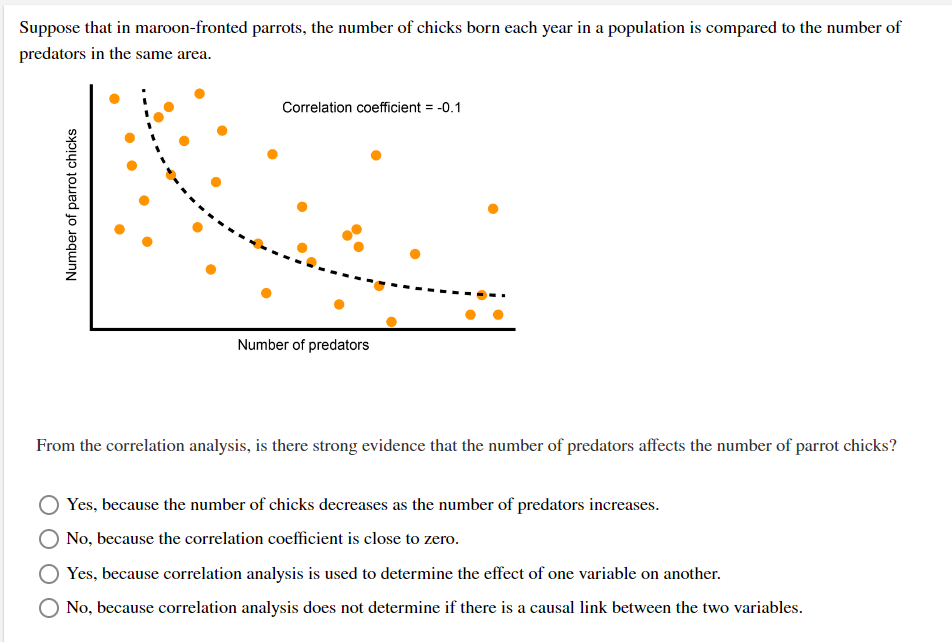Suppose that in maroon-fronted parrots, the number of chicks born each year in a population is compared to the number of predators in the same area. Correlation coefficient = -0.1 Number of predators From the correlation analysis, is there strong evidence that the number of predators affects the number of parrot chicks? Yes, because the number of chicks decreases as the number of predators increases. No, because the correlation coefficient is close to zero. Yes, because correlation analysis is used to determine the effect of one variable on another. O No, because correlation analysis does not determine if there is a causal link between the two variables. Number of parrot chicks
Suppose that in maroon-fronted parrots, the number of chicks born each year in a population is compared to the number of predators in the same area. Correlation coefficient = -0.1 Number of predators From the correlation analysis, is there strong evidence that the number of predators affects the number of parrot chicks? Yes, because the number of chicks decreases as the number of predators increases. No, because the correlation coefficient is close to zero. Yes, because correlation analysis is used to determine the effect of one variable on another. O No, because correlation analysis does not determine if there is a causal link between the two variables. Number of parrot chicks
Human Anatomy & Physiology (11th Edition)
11th Edition
ISBN:9780134580999
Author:Elaine N. Marieb, Katja N. Hoehn
Publisher:Elaine N. Marieb, Katja N. Hoehn
Chapter1: The Human Body: An Orientation
Section: Chapter Questions
Problem 1RQ: The correct sequence of levels forming the structural hierarchy is A. (a) organ, organ system,...
Related questions
Question

Transcribed Image Text:Suppose that in maroon-fronted parrots, the number of chicks born each year in a population is compared to the number of
predators in the same area.
Correlation coefficient = -0.1
Number of predators
From the correlation analysis, is there strong evidence that the number of predators affects the number of parrot chicks?
Yes, because the number of chicks decreases as the number of predators increases.
No, because the correlation coefficient is close to zero.
Yes, because correlation analysis is used to determine the effect of one variable on another.
No, because correlation analysis does not determine if there is a causal link between the two variables.
Number of parrot chicks
Expert Solution
This question has been solved!
Explore an expertly crafted, step-by-step solution for a thorough understanding of key concepts.
This is a popular solution!
Trending now
This is a popular solution!
Step by step
Solved in 2 steps

Knowledge Booster
Learn more about
Need a deep-dive on the concept behind this application? Look no further. Learn more about this topic, biology and related others by exploring similar questions and additional content below.Recommended textbooks for you

Human Anatomy & Physiology (11th Edition)
Biology
ISBN:
9780134580999
Author:
Elaine N. Marieb, Katja N. Hoehn
Publisher:
PEARSON

Biology 2e
Biology
ISBN:
9781947172517
Author:
Matthew Douglas, Jung Choi, Mary Ann Clark
Publisher:
OpenStax

Anatomy & Physiology
Biology
ISBN:
9781259398629
Author:
McKinley, Michael P., O'loughlin, Valerie Dean, Bidle, Theresa Stouter
Publisher:
Mcgraw Hill Education,

Human Anatomy & Physiology (11th Edition)
Biology
ISBN:
9780134580999
Author:
Elaine N. Marieb, Katja N. Hoehn
Publisher:
PEARSON

Biology 2e
Biology
ISBN:
9781947172517
Author:
Matthew Douglas, Jung Choi, Mary Ann Clark
Publisher:
OpenStax

Anatomy & Physiology
Biology
ISBN:
9781259398629
Author:
McKinley, Michael P., O'loughlin, Valerie Dean, Bidle, Theresa Stouter
Publisher:
Mcgraw Hill Education,

Molecular Biology of the Cell (Sixth Edition)
Biology
ISBN:
9780815344322
Author:
Bruce Alberts, Alexander D. Johnson, Julian Lewis, David Morgan, Martin Raff, Keith Roberts, Peter Walter
Publisher:
W. W. Norton & Company

Laboratory Manual For Human Anatomy & Physiology
Biology
ISBN:
9781260159363
Author:
Martin, Terry R., Prentice-craver, Cynthia
Publisher:
McGraw-Hill Publishing Co.

Inquiry Into Life (16th Edition)
Biology
ISBN:
9781260231700
Author:
Sylvia S. Mader, Michael Windelspecht
Publisher:
McGraw Hill Education